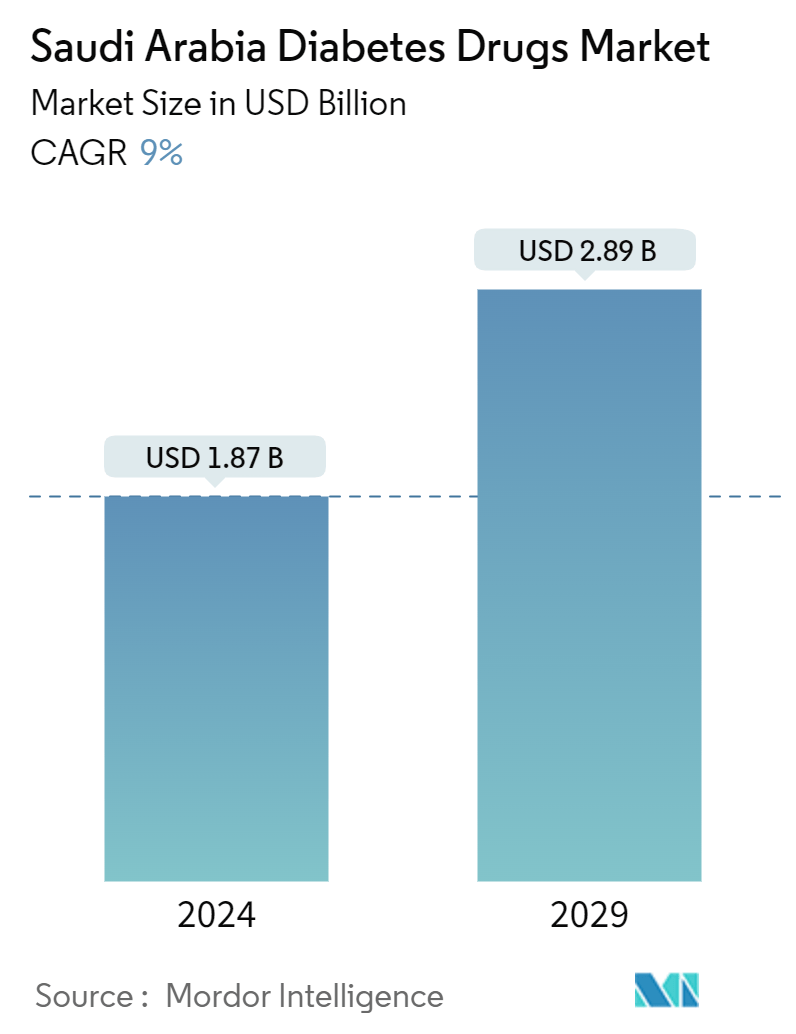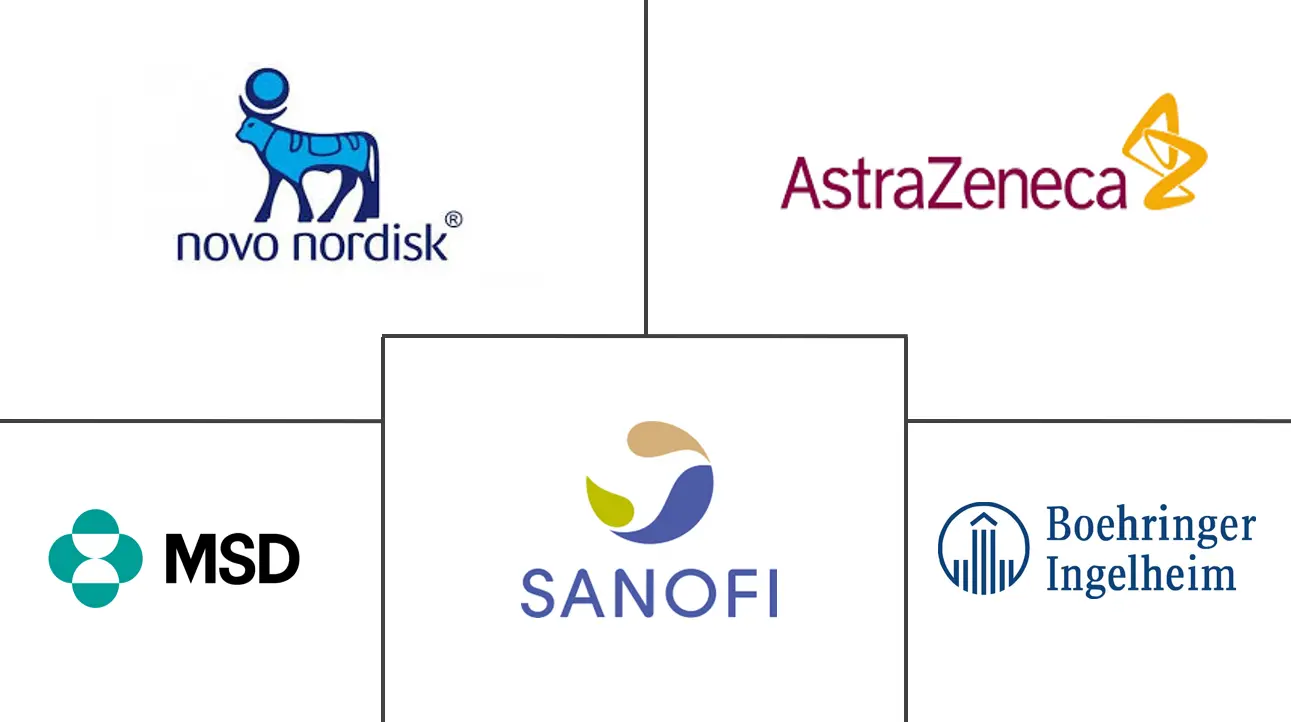Market Size of Saudi Arabia Diabetes Drugs Industry

| Study Period | 2018 - 2029 |
| Base Year For Estimation | 2023 |
| Forecast Data Period | 2024 - 2029 |
| Market Size (2024) | USD 1.87 Billion |
| Market Size (2029) | USD 2.89 Billion |
| CAGR (2024 - 2029) | 9.00 % |
Major Players
*Disclaimer: Major Players sorted in no particular order |
Saudi Arabia Diabetes Drugs Market Analysis
The Saudi Arabia Diabetes Drugs Market size is estimated at USD 1.87 billion in 2024, and is expected to reach USD 2.89 billion by 2029, growing at a CAGR of 9% during the forecast period (2024-2029).
More than one in ten people in Saudi Arabia are now living with diabetes and the prevalence of the disease will almost double by 2045, according to the report by the International Diabetes Federation (IDF). The IDF report mentioned that 4.27 million people in Saudi Arabia - which has a population of about 34.8 million have diabetes, while a further 1.86 million people have the disease but are yet to be diagnosed. This figure will increase to 5.6 million by 2030 and further to 7.5 million by 2045. Due to the early age and longer diabetes duration, the youth is at risk of developing diabetes at a younger age, which lessens their quality of life, shortens life expectancy, and increases healthcare costs to society.
The prevalence of diabetes is growing among all ages in Saudi Arabia, which can be attributed to the increasingly obese population, an unhealthy diet, and a sedentary lifestyle. When diabetes is undetected or inadequately treated, people with diabetes are at risk of serious and life-threatening complications, such as heart attack, stroke, kidney failure, blindness, and lower-limb amputation. These result in reduced quality of life and higher healthcare costs, leading to a greater need for access to care. The rising prevalence of diabetes and obesity, growing awareness of diabetic care, healthcare expenditure, and technological advancements are a few factors that are further driving the market.
Saudi Arabia is aiming to reduce the prevalence of diabetes by 10% over the next decade. Several initiatives, including taxing sugary drinks, fitness programs, and focusing on preventative care, are being taken by the government to stem this epidemic. The government's focus on combating diabetes and the higher purchasing power of the people in the country may help the market for diabetes drugs during the forecast period.
Saudi Arabia Diabetes Drugs Industry Segmentation
Diabetes Drugs are used to manage diabetes mellitus by lowering the glucose level in the blood. The Saudi Arabia Diabetes Drugs Market is segmented into drugs. The report offers the value (in USD) and volume (in units) for the above segments.
| Insulins | |||||||
| |||||||
| |||||||
| |||||||
|
| Oral Anti-diabetic drugs | ||||||
| ||||||
| ||||||
| ||||||
| ||||||
| ||||||
| ||||||
|
| Non-Insulin Injectable drugs | |||||||
| |||||||
|
| Combination drugs | |||||
| |||||
|
Saudi Arabia Diabetes Drugs Market Size Summary
The Saudi Arabia Diabetes Drugs Market is experiencing significant growth, driven by the increasing prevalence of diabetes and obesity in the country. With a substantial portion of the population affected by diabetes, the demand for effective diabetes management solutions is on the rise. The market is characterized by a strong focus on oral anti-diabetic drugs, which hold a dominant share due to their efficacy, safety, and cost-effectiveness. The government's initiatives to combat diabetes, such as taxing sugary drinks and promoting preventive care, are expected to further bolster the market. Additionally, technological advancements and growing awareness of diabetic care are contributing to the market's expansion.
The market landscape is consolidated, with major pharmaceutical companies like Eli Lilly, Sanofi, Novo Nordisk, and AstraZeneca playing a pivotal role. These companies are actively engaging in strategy-based mergers and acquisitions to enhance their market presence and explore new revenue streams. The Sulfonylureas segment is anticipated to witness the highest growth rate, reflecting the increasing adoption of these oral anti-diabetic agents. Government efforts to improve healthcare access and affordability, alongside global initiatives like the WHO Global Diabetes Compact, are expected to create a conducive environment for market growth. As the country continues to address the diabetes epidemic, the market for diabetes drugs is poised for substantial development in the coming years.
Saudi Arabia Diabetes Drugs Market Size - Table of Contents
-
1. MARKET DYNAMICS
-
1.1 Market Overview
-
1.2 Market Drivers
-
1.3 Market Restraints
-
1.4 Porter's Five Forces Analysis
-
1.4.1 Bargaining Power of Suppliers
-
1.4.2 Bargaining Power of Consumers
-
1.4.3 Threat of New Entrants
-
1.4.4 Threat of Substitute Products and Services
-
1.4.5 Intensity of Competitive Rivalry
-
-
-
2. MARKET SEGMENTATION
-
2.1 Insulins
-
2.1.1 Basal or Long Acting Insulins
-
2.1.1.1 Lantus (Insulin Glargine)
-
2.1.1.2 Levemir (Insulin Detemir)
-
2.1.1.3 Toujeo (Insulin Glargine)
-
2.1.1.4 Tresiba (Insulin Degludec)
-
2.1.1.5 Basaglar (Insulin Glargine)
-
-
2.1.2 Bolus or Fast Acting Insulins
-
2.1.2.1 NovoRapid/Novolog (Insulin Aspart)
-
2.1.2.2 Humalog (Insulin Lispro)
-
2.1.2.3 Apidra (Insulin Glulisine)
-
-
2.1.3 Traditional Human Insulins
-
2.1.3.1 Novolin/Actrapid/Insulatard
-
2.1.3.2 Humulin
-
2.1.3.3 Insuman
-
-
2.1.4 Biosimilar Insulins
-
2.1.4.1 Insulin Glargine Biosimilars
-
2.1.4.2 Human Insulin Biosimilars
-
-
-
2.2 Oral Anti-diabetic drugs
-
2.2.1 Biguanides
-
2.2.1.1 Metformin
-
-
2.2.2 Alpha-Glucosidase Inhibitors
-
2.2.2.1 Alpha-Glucosidase Inhibitors
-
-
2.2.3 Dopamine D2 receptor agonist
-
2.2.3.1 Bromocriptin
-
-
2.2.4 SGLT-2 inhibitors
-
2.2.4.1 Invokana (Canagliflozin)
-
2.2.4.2 Jardiance (Empagliflozin)
-
2.2.4.3 Farxiga/Forxiga (Dapagliflozin)
-
2.2.4.4 Suglat (Ipragliflozin)
-
-
2.2.5 DPP-4 inhibitors
-
2.2.5.1 Onglyza (Saxagliptin)
-
2.2.5.2 Tradjenta (Linagliptin)
-
2.2.5.3 Vipidia/Nesina(Alogliptin)
-
2.2.5.4 Galvus (Vildagliptin)
-
-
2.2.6 Sulfonylureas
-
2.2.6.1 Sulfonylureas
-
-
2.2.7 Meglitinides
-
2.2.7.1 Meglitinides
-
-
-
2.3 Non-Insulin Injectable drugs
-
2.3.1 GLP-1 receptor agonists
-
2.3.1.1 Victoza (Liraglutide)
-
2.3.1.2 Byetta (Exenatide)
-
2.3.1.3 Bydureon (Exenatide)
-
2.3.1.4 Trulicity (Dulaglutide)
-
2.3.1.5 Lyxumia (Lixisenatide)
-
-
2.3.2 Amylin Analogue
-
2.3.2.1 Symlin (Pramlintide)
-
-
-
2.4 Combination drugs
-
2.4.1 Insulin combinations
-
2.4.1.1 NovoMix (Biphasic Insulin Aspart)
-
2.4.1.2 Ryzodeg (Insulin Degludec and Insulin Aspart)
-
2.4.1.3 Xultophy (Insulin Degludec and Liraglutide)
-
-
2.4.2 Oral Combinations
-
2.4.2.1 Janumet (Sitagliptin and Metformin)
-
-
-
Saudi Arabia Diabetes Drugs Market Size FAQs
How big is the Saudi Arabia Diabetes Drugs Market?
The Saudi Arabia Diabetes Drugs Market size is expected to reach USD 1.87 billion in 2024 and grow at a CAGR of 9% to reach USD 2.89 billion by 2029.
What is the current Saudi Arabia Diabetes Drugs Market size?
In 2024, the Saudi Arabia Diabetes Drugs Market size is expected to reach USD 1.87 billion.

